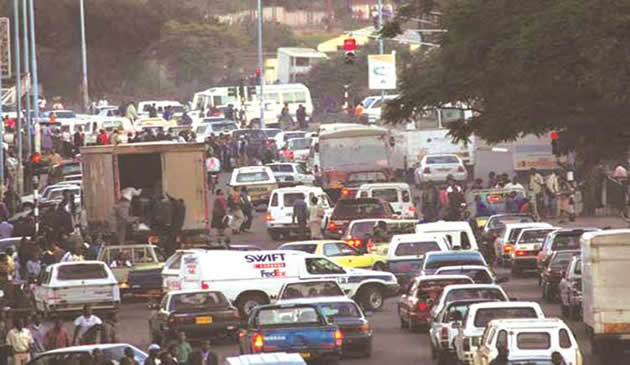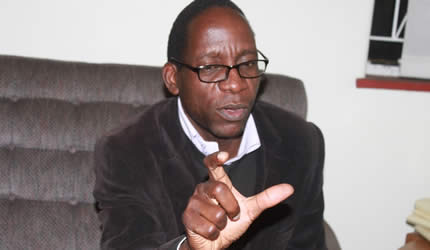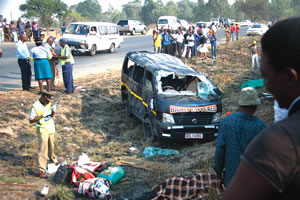Zim to align road rules with Sadc

 Peter Matambanadzo and Nyemudzai Kakore
Peter Matambanadzo and Nyemudzai Kakore
Government will soon introduce four-way stop intersections at which all vehicles will be compelled to stop on approaching, and replace road signs to comply with road traffic regulations in Sadc. Carriage markings will also be redesigned to match with those in other countries in the region.
The Zimbabwe Traffic Safety Council said the four-way stop system was generally safer than traditional stop signs or signal-controlled intersections.
A four-way stop, also known as an all-way stop, is an intersection system used where traffic approaching from all directions is required to stop at all times before proceeding through the intersection.
The development is part of a new road traffic system that will be incorporated into the new Highway Code set to be launched by the TSCZ, under the Ministry of Transport and Infrastructure Development next year.
TSCZ managing director Mr Obio Chinyere yesterday said the introduction of four-way stops was one of the major changes in the new Highway Code as part of alignment of the country’s traffic rules and regulations with those of other Sadc countries.
“The new road traffic system is a new section introduced in our Highway Code and is set to improve safety and reduce accidents,” Mr Chinyere said.
He said the four-way stop junction had many advantages since it did not require installation of expensive traffic lights,
The basic rule is that it all drivers must reduce speed and stop before proceeding. The first car to get to the stop will be the first to proceed through the intersection.
“We have looked at other highway codes in the region and, for example, we have discovered that the four-way stops are commonly used and are very effective in countries such as Namibia and South Africa,” he said.
Mr Chinyere said the country was facing electricity challenges which constantly affected traffic lights and the four-way stop would go a long way in reducing accidents and traffic jams.
He said the Highway Code would also introduce Sadc road traffic signs and dual markings in line with the regional bloc’s Protocol on Transport, Communication and Meteorology.
The Protocol requires the region to harmonise road infrastructure.
“All Sadc countries are now required to have uniform traffic control devices and this includes road markings, signs and traffic signals,” Mr Chinyere said.
The main reason for the use of stop signs at road junctions is safety.
Four-way stop signs are widely used in other countries such as the United States, Canada, Sweden, South Africa and Namibia.
Stop-controlled intersections are believed to be safer than those without any traffic control.
According to an international study of locations where the system is in use, all-way stop controls applied to four-legged intersections may reduce accident occurrence by 45 percent.
Meanwhile, people have expressed outrage over the Traffic Safety Council of Zimbabwe’s decision to introduce new regulations that will penalise pedestrians who cross roads at undesignated points.
TSCZ recently announced plans to tighten the Highway Code by penalising pedestrians with a jail term of up to six months or a US$20 fine starting next year for violating traffic laws.
A snap survey of pedestrians conducted by The Herald yesterday showed many people thought the measures were impractical because of the influx of cars in the country and the fact that many traffic lights were either not user-friendly or not working at all.
“Most of the traffic lights are not working as we do not have proper technology used in other countries where pedestrians also have control over traffic lights,” said Takaidza Takaidza of Chitungwiza.
“Robots are not functional and our road markings are bad. The council needs to ensure that all pedestrian crossings are clearly marked and that motorists also respect pedestrians who are road users as well.”
Said Mary Shelton who works in Harare: “The authorities have to first invest heavily in the repair and maintenance of all the existing traffic signs and lights.
“They must repair the city’s pothole filled roads to ensure safe crossing points for pedestrians.
“I do not think it is a reasonable idea in the city considering the traffic jams which occur during peak hour. It means I will have to wait for hours before I cross; motorists do not pave way for pedestrians during peak periods.”
Others felt TSCZ should focus more on protecting rather than punishing pedestrians.
Clara Mangeya said: “The Traffic Safety Council should first ensure that traffic lights are functional and all zebra crossings clearly marked before they move to punish pedestrians.”
However, others said the regulations would restore sanity in urban centres and reduce road traffic accidents.
“There should be strict regulations on pedestrians because we experience many road accidents and deaths because of pedestrians crossing in the wrong places,” said Blessing Moyo, a commuter omnibus driver.
Some said more emphasis should be put on restoring sanity at ranks and termini where kombi drivers, touts and marshals did as they pleased.
The new Highway Code will encompass all road users unlike in the past when it emphasised rules for motorists and cyclists.
The current Highway Code was formulated in 1972, and TSCZ officials said it was outdated.







Comments